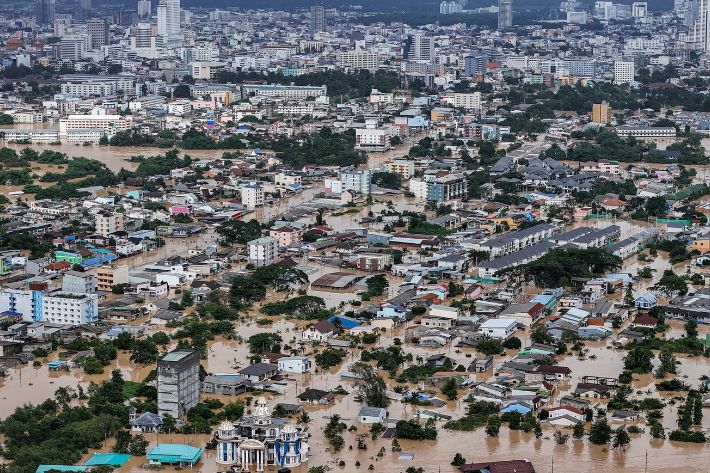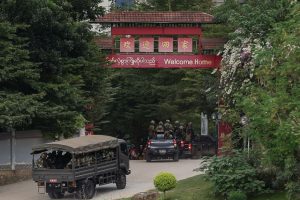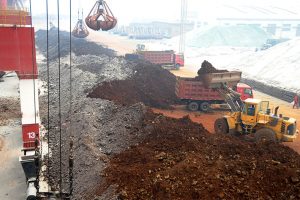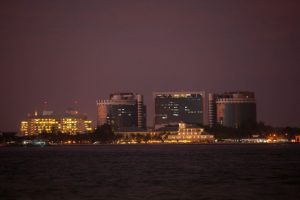More than 130 people have died in record floods that have swamped parts of Vietnam, Malaysia and southern Thailand.
In Vietnam, which was struck last week, at least 98 people died, while the toll in Thailand is currently 33. And that could easily rise, given critically-ill patients are having to be flown out of the intensive care unit at the main hospital in Hat Yai.
The floods cover a vast region that stretches all over Songkhla province and down into Malaysia, and even further south to Sumatra Island in Indonesia.
ALSO SEE: China’s Mines Poisoning SE Asian Rivers, Global Food Supplies
Hat Yai, which has a population of about 200,000 people, is expected to be inundated for weeks.
The latest deluge was caused by record rainfall last week – with 335mm (13 inches) on a single day, which was allegedly the highest tally in 300 years.
Meteorologists blame global warming, but say two major climate systems – La Niña and a negative Indian Ocean Dipole, which causes warmer sea surface temperatures – spurred huge downpours across the region.
Major economic impact
The economic cost is likely to be hefty, already estimated at 1 to 5 billion baht a day ($33 million to $155 million).
Authorities in Thailand were sending helicopters on Wednesday (Nov 26) to evacuate the most serious of patients marooned in a government hospital by the region’s worst floods in years, as more rain is expected.
Floods have swept through nine Thai provinces and eight states in neighbouring Malaysia for a second successive year, prompting both countries to evacuate nearly 45,000 people.
In Indonesia, eight to 13 people were reported dead following floods and landslides this week, while one has also died in Malaysia.

Helicopters flying ICU patients out
In Hat Yai, Thailand’s hardest-hit city, a public health official said helicopters were delivering food and ferrying out patients after the first floor of the main hospital treating 600 people, with 50 in intensive care, was inundated.
“Today, all intensive care patients will be transported out of Hat Yai Hospital,” the ministry official, Somrerk Chungsaman, told Reuters.
About 20 helicopters and 200 boats drafted into the Hat Yai rescue effort have had difficulty reaching stranded people, government spokesman Siripong Angkasakulkiat told reporters.
Boats carrying in supplies
Patients, relatives and medical staff at the hospital number around 2,000 and boats should be able to carry in food as the waters recede, Somrerk said.
Military helicopters were also carrying generators to the hospital, the Thai Navy said, posting photographs on social media of equipment being moved to a rooftop under dark grey skies.
Floods across nine Thai provinces, including Songkhla, where Hat Yai is located, have affected more than 980,000 homes and over 2.7 million people, the interior ministry said.
Thai weather officials forecast scattered thundershowers and heavy rains on Wednesday in several southern provinces, including Songkhla.
Convoys of aircraft and trucks were moving flat-bottomed boats and rubber dinghies towards Hat Yai, along with medical supplies and personnel, said the Thai military, which took charge of relief efforts on Tuesday.

Aircraft carrier providing support
Thailand’s only aircraft carrier, Chakri Naruebet, set out from Sattahip, its home port near Pattaya, on Tuesday to provide air support, medical assistance and meals in the relief efforts, the navy said.
Rescuers pulled stranded families, including children and the elderly, from homes inundated by swirling brown waters, photographs posted by the Thai army showed.
Many of the stranded took to websites and social media to seek help.
“Please help. I’m very worried about my mother,” wrote one person, adding that she had been unable to contact the 53-year-old in Hat Yai since Saturday, when domestic supplies were down to just a bottle of water and two packs of instant noodles.
- Jim Pollard with Reuters
ALSO SEE:
Carbon Removal Credits in Short Supply As AI Firms Step Up Demand
EU To Reject India’s Demand For Carbon Tax Exemption
Climate Chaos ‘Could Disrupt Half of Global Chipmaking by 2050’
Asia’s Billion-Dollar Carbon Boom?
India’s Green Transition In A Chokehold
As Typhoons Lash Southeast Asia, COP30 Hunts Adaptation Finance
Central Banks Unprepared For Climate-Driven Labour Shocks: LSE
Firms Underestimating Risks From Carbon-Fuelled Climate Change
Carbon Removals Not Growing Fast Enough For Climate Goals
Firms May Abandon Net-Zero Plans Amid Carbon Offset Uncertainty























